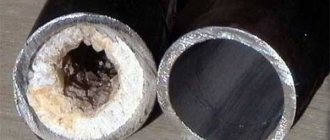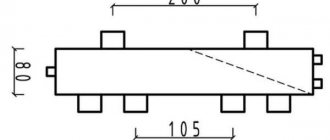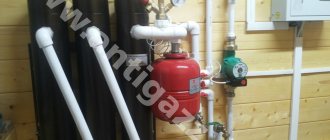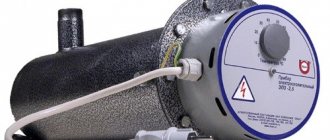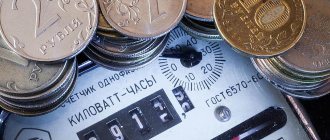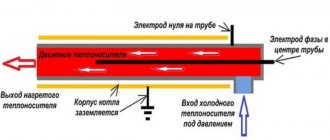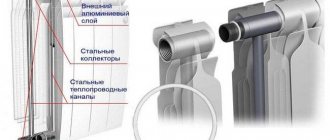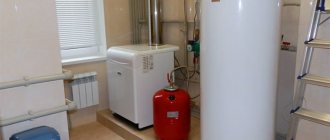Inductive-conductive electric heaters (sometimes, for simplicity, they are called induction or vortex) appeared on the heating equipment market in the 90s of the last century and since then have significantly displaced the most common heating element and electrode boilers at that time. The balance of power has changed noticeably since then. Induction heaters have gained a share of about 30%, and this share continues to increase. Previously, we already looked at what the fundamental difference between these types of heaters is (here), but now we have to understand in more detail what is the reason for the success of induction heaters, because they are more expensive than their heating element counterparts. And the reason is economics. This is what we will count today.
What is more important: acquisition cost or ownership cost?
Unlike countries with long-standing market traditions, in Russia the practice of calculating the full costs of purchasing and operating equipment over its entire service life is still not widespread. To some extent, this is due to economic uncertainty and short planning horizons at domestic enterprises. Most companies live for today, limiting themselves to plans for the next financial year. Therefore, the main criterion when choosing equipment is often the cost of its acquisition. The rest of the consumer properties of the product take a secondary role: “so what if this heater works 10 times longer? Who knows what will happen to us in a year? Maybe we'll go broke or I won't work here. Why overpay?!” Unfortunately, such “argumentation” often comes up when issues of allocating funds for this or that rather expensive equipment are discussed. As a result, poor or short-sighted decisions are made.
►See Equipment for autonomous heating in our catalog
In countries with developed economies, such questions cannot arise in principle, especially in relation to equipment on which the life of an enterprise depends. To be fair, it should be noted that many of our specialists and managers practice a balanced approach in their work: not only the purchase price is taken into account, but also those costs that will arise during operation over a long period of time (ideally, during the entire service life equipment). The most prudent and far-sighted also calculate the risks associated with ownership and operation - this is a sign of their highest professionalism. Our article can help such specialists.
Manufacturers of electric heating equipment
The domestic market offers products from various manufacturers. Not only foreign but also Russian companies lead the list.
Among the most popular are boilers from companies:
- Dacon (Czech Republic) its model range consists of 30 modifications of devices with power from 4 to 60 kW, while boilers up to 12 kW can be connected to a single- and three-phase network. Some of the samples, for example PTE L, have quiet running contactors, a circulation pump, a safety valve and an expansion tank.
- Kospel (Poland) - the company's products are single-circuit devices, as well as electric electrode boilers with multi-stage power phases in the range from 4 to 36 kW. They differ in the method of adjustment: manual and software. Basic models include: EKCO R, EKCO L 1, EKCO L.
- RusNIT (Russia) - represented by N and Country samples, they have a power range from 3 to 55 kW and are adapted to work under conditions of power surges in the network.
Payment terms
To ensure that our comparison is objective and impersonal, we will not use specific brands of equipment or specific objects in our analysis. Moreover, since the price range is extremely wide, there is no point in choosing a specific brand of product. We use average figures, which, however, are subject to comparison: prices, power and completeness of conventional products are quite comparable. 50 kW is the power of the induction heater and 50 kW of the heater (and in the latter, we will assume there are only 10 heating elements of 5 kW each).
We will compare at current average prices, without taking into account inflation and regional reference, since if you enter this data, the calculations will become much more complicated: each region has its own tariff setting, and the official inflation rate has little connection with the level of annual growth in electricity tariffs, so we will omit these factors .
We are not particularly interested in the characteristics of the heated object: if heating a room requires 50 kW of energy (or 43,000 kcal), then it does not matter which heater we choose - a heating element or an induction one - to maintain the desired temperature, they must produce the same amount of heat. We can only say that a 50 kW boiler can approximately heat a facility with a total area of about 600 m2 with a ceiling height of 3 m (responsible boiler suppliers will never recommend their equipment without assessing the facility where the equipment will operate and will always offer to make a calculation based on specific characteristics object).
Types of devices
Heating elements differ in structure:
- smooth, with a flat surface of the tubular element, used for heating boilers;
- finned, attached to the tube with clamping nuts and washers, and the ribs are made of metal tape and have notches perpendicular to the axis of the rod; the heating element itself is made of structural steel or stainless steel, serves for heating air and gas, and is often used in convectors and thermal curtains.
By number of connections:
- Single-ended, in which the water contacts are located on one side, their shape and structure remotely resemble a boiler. More often used as parts for electric boilers, they are always heated with the same power, they are produced by Zota, Evan, SINI, etc.;
- double-ended heating elements, where water contacts are mounted at both ends of the tube.
One, two, three or more heating elements (stages, blocks) are installed in a heating boiler, which affects the power of the device. The minimum power of one heating element is 1 kW, the maximum depends on the customer and the type of room for which the device is intended. The length of the product varies between 20-600 cm, the diameter of the tube is 6-18.5 mm. Tubular elements are connected to heating boilers using threads, stationary or collapsible flanges.
Heating element blocks are considered a separate type, which correspond to the marking of heating elements. Their production is carried out exclusively by the Zota company, which has received a patent and exclusive rights to mass sales.
Finned heating element with two ends
Operation of electric boilers: first year
The main costs in the first year of operation will obviously be investments in the purchase and installation of equipment. Induction heaters are more expensive, but their installation and startup is no more difficult than that of a heating element boiler. Operating costs in the first year are also almost the same:
| First year | Induction heater | New heating element |
| Purchase cost | 145 000 | 40 000 |
| Safety stock 1 heating element (2 pcs.) | 0 | 4 000 |
| Heating period2, days. | 200 | 200 |
| Continuous operation time3, hour/day. | 10 | 10 |
| Energy tariff | 2,8 | 2,8 |
| Electricity costs, rub/season | 50×200×10×2,8=280 000 | 50×200×10×2,8=280 000 |
| Accident risk4 | 0 | 0 |
| Costs of consumables, rub. | 0 | 0 |
| Labor costs for operation5 | 0 | 0 |
| Total expenses at the end of the period | 145 000+280 000=425 000 | 40 000+4 000+280 000=324 000 |
1It is not necessary to create a stock of replacement elements, but this threatens, in the event of an emergency failure of the heating element, with a reduction in the design power of the equipment, therefore most operators of heating element boilers create a stock of heating elements. And they do it right!
2In Russia there are different climatic zones, and accordingly, the duration of the heating season is different - from 148 days (in Maykop) to 311 (in Anadyr). We use an average figure of 200 days (approximately the latitude of Lipetsk or Tambov).
3If the heater operates continuously during the season, then the equipment is not selected correctly. Typically, equipment is selected in such a way as to work, on average, for 8-10 hours a day
4An accident is considered to be the failure of the heating element, or a decrease in its power by more than 50%. The service life of the heating element is about 5,000 hours. However, there is a possibility that it will last less or longer than expected. We will not consider the “less” option: let’s say that neither the manufacturer of the heating element boiler nor the manufacturer of the induction boiler allowed the defect. And in the first year (2,000 hours of operation) not a single heating element burned out.
5It is absolutely impossible to do without labor costs: an energy specialist, one way or another, must carry out preventive maintenance and monitor the operation of the equipment, however, since there were no equipment failures, we will assume that the operating costs in the first year for the two types of electric boilers are approximately equal and will not take them into account.
As a result, the first year of operation ended with a convincing superiority of the shadow electric cat. The costs for it, taking into account the purchase of equipment, are almost a quarter lower. Can we celebrate the victory? It's a bit early. The equipment was purchased for more than one season - we’ll see what happens next.
Experts advise
Purchasing heating equipment is a rather complicated issue. It must meet many parameters, but which ones should you pay attention to first? Experts recommend first calculating the boiler power.
Moreover, for electric models, the network to which it will be connected depends on it. Most models with a power rating of up to 12 kW are single-phase, and those exceeding this threshold are three-phase. Typically, the boiler power is calculated using the formula, or in the case of good insulation of the building, it is taken at the rate of 1 kW per 1 m².
The next parameter is the efficiency of the device. It depends on its type, as well as on the presence of several stages of power adjustment. This parameter makes it possible to rationally use energy, especially in autumn or spring.
It is necessary to pay attention to the equipment, it can be different. There are electrode-electric boilers equipped with an expansion tank and a circulation pump, as well as a safety group, that is, they are a mini-boiler room. But there are also the simplest samples that do not have any additional equipment, which are best used only as backup sources of heating the coolant.
Only taking into account all the considered parameters can you choose the most optimal boiler option, which will consume energy economically and maintain a comfortable temperature in the room.
Operation of electric boilers: second year
It’s not very obvious yet, but changes are starting to happen. Due to the high surface temperature of the heating elements of the heating element boiler, water boils in the boundary layer and scale is inevitably deposited. Its micron thickness is not even visible to the naked eye, but even such scale significantly reduces heat transfer, which is why heat removal decreases. The heating element heats up more, but the water, on the contrary, heats up worse. According to various estimates, the heat transfer efficiency of a heating element boiler may drop by 20% already in the first year of operation. We will try to be extremely objective and calculate this figure as equal to 10%, and only from the second year of operation. In real terms, this would mean that the heater would have to run 10% longer than a brand new heater to produce the required amount of heat energy.
An induction heater does not have such problems: the developed heat exchange area of the heat exchange device and the small temperature difference between the coolant and the heat exchanger (only 10-20°C) do not create conditions for scale deposits. In addition, natural magnetization of water occurs in an induction heater, which also increases its resistance to scale formation. There is no loss of power.
In addition, the heating elements have already worked for 4000 hours and are close to expiring their warranty period. The probability that one of the elements will require replacement during the second season is small - let’s take it equal to 10%. That is, out of ten heating elements, one will have to be replaced. The price of the heating element seems insignificant - about 2000 rubles. However, the electrician will have to work with the installation, and labor costs begin to count.
| Second year | Induction heater | New heating element |
| Heating period, days. | 200 | 200 |
| Continuous operation time, hour/day. | 10 | 11 |
| Energy tariff | 2,8 | 2,8 |
| Electricity costs, rub/season | 50×200×10×2,8=280 000 | 50×200×11×2,8=308 000 |
| Risk of accident | 0 | 10 |
| Costs of consumables, rub. | 0 | 2,000 (replacement of 1 heating element) |
| Labor costs for operation* | 0 | 190 |
| Current expenses for the period | 280 000 | 308 000+2 000+190=310 190 |
| Total expenses on a cumulative basis | 425 000+280 000=705 000 | 324 000+310 190=634 190 |
*We will assume the time to replace the heating element to be 1 hour (although in reality this figure may vary greatly). We have prudently created a stock of heating elements, so time is spent only on replacement. With an electrician's salary of 30,000 rubles/month. the cost of replacing one heating element will be only about 190 rubles. If a third-party specialist does the work, it will be about 10 times more expensive.
As you can see, at the end of the second year of operation, a heating element boiler turns out to be more profitable than an induction boiler, although not by such a convincing margin: the difference in costs is only about 10%. At the same time, the heating element heater begins to attract unnecessary attention. How much of this attention is required depends on the quality of the boiler itself, the operating conditions, and the quality of the coolant preparation. For now, we are considering a fairly favorable situation for heating elements, so that we are not accused of subjectivity and the desire to denigrate a competitive product.
Induction boilers
Induction water heating boilers began to be used for industrial purposes back in the 80s of the last century, and in the mid-90s the first models for domestic use appeared.
The operation of the boiler is based on the principle of electromagnetic induction. The main element of the system is an inductive coil, which, using a current of 50 Hz, creates an alternating magnetic field. The inductive coil is also a generator, which is due to the placement of the conductor in a magnetic field, thus reducing the level of electricity consumption. Due to magnetization reversal, the system of labyrinths made of ferromagnetic metal is heated, and thermal energy is transferred to the coolant with virtually no losses. Due to the design features and heating method, the use of induction boilers has a number of advantages:
— the absence of a heating element in direct contact with the coolant solves the problem of scale formation, which guarantees a constant efficiency and eliminates the need for periodic replacement of this element; — high efficiency (manufacturers declare up to 99.5%, but one must take into account the seller’s desire to somewhat exaggerate the merits of his product); — stable operation of the equipment practically does not depend on the ambient temperature, which reduces the probability of boiler failure to almost zero; — the boiler design has virtually no flanged or threaded connections, which gives it additional reliability and significantly reduces the likelihood of leakage; — thanks to the heating method used, almost any liquid (water, oil, antifreeze, etc.) can act as a coolant; no special requirements are imposed on it; — durability (at least 30 years) is due to the absence of moving parts; — simplicity and safety of operation.
To the disadvantages
This may include the rather high cost of such boilers, the impossibility of smooth load adjustment (only stepwise) and high weight compared to other types of equipment.
Operation of electric boilers: third year
The changes that began at the end of the first year of operation are beginning to progress. There is more and more scale, although it is still not visible to the naked eye, and the system was flushed with an anti-scale agent in the summer. However, the design of the heating element is such that a drop in power occurs not only due to scale deposits, but also throughout its entire service life. Continuous operation time increased by another 15%. The warranty limit of 5000 operating hours has been exceeded. Of course, all heating elements will not burn out at once, but from this moment the countdown of days to an accident begins. The risk of failure increases significantly – up to 30%.
There are few changes in the induction electric boiler. During the summer, as a preventative measure, his heat exchanger was also washed and its energy characteristics remained unchanged.
| Third year | Induction heater | New heating element |
| Heating period, days. | 200 | 200 |
| Continuous operation time, hour/day. | 10 | 12,65 |
| Energy tariff | 2,8 | 2,8 |
| Electricity costs, rub/season | 50×200×10×2,8=280 000 | 50×200×12,65×2,8=354 200 |
| Risk of accident | 0 | 30 |
| Costs of consumables, rub. | 0 | 6,000 (replacement of 3 heating elements) |
| Labor costs for operation* | 0 | 570 |
| Current expenses for the period | 280 000 | 354 200+6 000+570=360 770 |
| Total expenses on a cumulative basis | 705 000+280 000=985 000 | 634 190+360 770=994 960 |
And so, by the end of the third heating season, the scales swung in favor of the induction boiler. Not only has the inductive-conductive unit become more cost-effective, but the shadow unit has also begun to constantly distract attention: there has been a noticeable increase in worries about it.
Purpose of heating elements
They differ in purpose:
- Heating elements with a thermostat - used for electric boilers, they are the safest because they are protected from overheating;
- for water heating - present in boilers with two circuits, they heat water, which then enters the CO and DHW, these include Ariston heating elements, whose distinctive feature is a brass base, sold in straight form for vertical boilers, and curved form for horizontal boilers;
- for the battery - mounted directly into the radiator itself, made of stainless steel, which resists corrosion, installation is carried out in a vertical position, there are cartridge, water and air types, the latter are used for cast iron and steel radiators;
- for heating boilers, which serve to maintain a given temperature in the intervals between heating the premises for gas and solid fuel boilers, this type of combined coolant is used by the Zota company.
Location of the heating element in the electric boiler
Operation of electric boilers: fourth year
There are no significant changes in the economy of our enterprise. We are already accustomed to the fact that during the season we need to regularly monitor the operation of the heating element boiler. They even installed a GSM control system on it. But we will not take these costs into account: after all, we agreed that we are evaluating a “clean pot” without piping.
Thermal productivity continues to decline, by 20%. It is due to the fact that the old heating elements are working. Their reliability is deceptive: they work, but they don’t provide power. As they say, it’s a pity to throw it away, but it’s more expensive to keep it.
By the end of the 4th year of operation, almost all heating elements that were once new had to be replaced. Still, some of them honestly worked 10 thousand hours – an excellent indicator.
With an induction heater you can only wipe off dust - absolutely nothing else.
| Fourth year | Induction heater | New heating element |
| Heating period, days. | 200 | 200 |
| Continuous operation time, hour/day. | 10 | 15,18 |
| Energy tariff | 2,8 | 2,8 |
| Electricity costs, rub/season | 50×200×10×2,8=280 000 | 50×200×15,18×2,8=425 040 |
| Risk of accident | 0 | 50 |
| Costs of consumables, rub. | 0 | 10,000 (replacement of 5 heating elements) |
| Labor costs for operation* | 0 | 950 |
| Current expenses for the period | 280 000 | 425 040+10 000+950=435 990 |
| Total expenses on a cumulative basis | 985 000+280 000=1 265 000 | 994 960+435 990=1 430 950 |
By the end of the fourth year of operation, the induction heater is already an absolutely confident leader in our competition, actually saving the enterprise money, not only monetary, but also time and human.
Only one thing can be said about the tensile boiler: if this continues, the electrician will only deal with it and will have to hire another one to work with the rest of the equipment...
Features of use
Advantages:
- stepped or block connection of heating elements saves energy up to 30%;
- the power is sufficient to heat not only CO, but also DHW, so heating elements are also suitable for installation in double-circuit boilers;
- do not form harmful compounds or combustion products;
- compact, therefore the electric boilers themselves are light in weight and have modest dimensions;
- are able to change shape under the influence of high temperatures without losing technical characteristics, so you can give them certain shapes with your own hands; the standard heating temperature of the heating element in the boiler is 80 °C.
Single-end heating element
Detailed information about the characteristics of heating elements for heating is in the video below.
Costs in the fifth year of operation
It seems that we have finally entered operating mode with the heating element boiler: everything has become more rhythmic and ordinary. Yes, you have to pay more for electricity, yes, you have to buy heating elements, yes, recently replaced elements begin to fail (the quality is dropping, perhaps?) and there was an unpleasant incident when a low-quality heating element broke and voltage “went” into the system. It’s good that the heater was grounded at the very beginning, otherwise troubles could not be avoided...
In general, it’s good that we only have a 50-kilowatt heater. What if it was 350? 7 times 50! How many heating elements are there, and how much would all our worries and expenses increase?
The induction heater hums slowly. After all, it is the “brother” of the transformer. It seems to be buzzing a little louder. Although, perhaps, this only seems - there is simply nothing more to complain about.
| Fifth year | Induction heater | New heating element |
| Heating period, days. | 200 | 200 |
| Continuous operation time, hour/day. | 10 | 15,18 |
| Energy tariff | 2,8 | 2,8 |
| Electricity costs, rub/season | 50×200×10×2,8=280 000 | 50×200×15,18×2,8=425 040 |
| Risk of accident | 0 | 50 |
| Costs of consumables, rub. | 0 | 10,000 (replacement of 5 heating elements) |
| Labor costs for operation* | 0 | 950 |
| Current expenses for the period | 280 000 | 425 040+10 000+950=435 990 |
| Total expenses on a cumulative basis | 1 265 000+280 000=1 545 000 | 994 960+435 990=1 430 950 |
Payback period for an induction heater
It makes no sense to describe all subsequent years of operation: the algorithm is already clear. Let's just say that from about the middle of the 3rd year of operation, the heating element boiler confidently breaks away from the induction boiler in terms of cost of ownership. And every year these costs will only grow.
I must say that we considered one of the most pessimistic forecasts for an induction heater - we dealt with heating element boilers as diplomatically as possible, because in fact:
- It rarely happens that a heating element lasts longer than 7,000 hours in a water heating system (we counted the operation of some heating elements for more than 10 thousand hours!).
- The power drop of a heating element boiler that has been running for some time can be up to 20% of the nominal value already in the first year of operation. We considered that in the first year there was no decline at all, and only the next year it happened. And that's only 10%.
- We considered that our staff already has the necessary energy specialist who has sufficient qualifications to quickly replace the heating element, and he does not get sick, does not go on vacation and sits, so to speak, with the heating element and a wrench in his hands, ready to rush at the first call for repairs... Does this happen to you? And if the company uses the services of a third-party specialist, the cost of “replacement” will increase at least 10 times.
- We have hardly touched upon the topic of differences in the electrical safety of boilers, but they also have a financial dimension. Electrical safety class 2 for an induction boiler (i.e., there is virtually no risk of electric shock) and electrical safety class 1 for heating elements and the risk of voltage leakage through water into the heating system (of course, there is automatic protection and grounding, but the fact remains that the risks are higher) .
The service life of a heating element boiler, despite the constant replacement of heating elements, is unlikely to exceed 10 years. An induction boiler can operate up to 100,000 hours, because at its core it is a “dry” transformer, the service life of which will end only when the impregnation of the windings of its coils finally ages and crumbles into dust. But this will happen no sooner than in 30 years (more about this in our article Service life - 30 years?!)!
What is such equipment?
Today, manufacturers produce many types of heating equipment that run on different types of fuel. Electric models are considered one of the simplest and most reliable.
They are:
- Tenovye
- Electrode
Let's look at each type. So, the first ones are heating devices, the operating principle of which is familiar to many. Electric heating elements for boilers, immersed in water, heat it to a given temperature. Ionic models differ from them in that in them the water becomes hot due to the movement of ions between the electrodes.
conclusions
In the worst case, when everything is not in favor of an induction electric heater, its purchase will still become more profitable after three years of operation. In practice, this deadline may come much earlier. And the higher the enterprise’s need for electric heating, and the more powerful the installations, the more profitable the purchase of induction electric boilers will be, because we based our calculations on a comparison of 50 kilowatt equipment and it’s not difficult to imagine how big the difference will be for, say, 500 -kilowatt electric boiler.
PS or answer to those who like to calculate NPV
There are specialists (usually with an economic education) who could say: “All this is nonsense! The author cites figures that are far from the real economy - he cites bare numbers, but in reality it is necessary to consider at least NPV (net present value), and then the whole picture may not be so rosy at all!”
Such arguments look ironclad. But only until we take and calculate this terrible NPV. Simply put, we can calculate how much we would earn if we had an amount of 145,000 rubles. and we could have bought an induction electric boiler, but we decided to save money and bought a shadow one for 40,000. And the saved money (105,000 rubles) would have been deposited in the bank at interest, and we would have even made money on it. Every year we would gain about 10% (in fact, most likely even less). By the end of the 5th year, we could withdraw 169,100 rubles from the bank. Those. would have received an additional 60 thousand in profit. There would be no limit to the joy until we returned to the calculations for our heaters. During the same time, we lost 321,940 rubles. - more than 5 times more than they earned. As they say, the miser pays twice. And then he pays extra.

